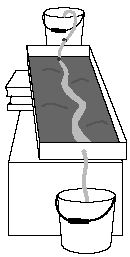Classroom Compass |
You will need:
| 
|
Each group will develop a model of a landscape. Have each group set up a stream table with the pan holding the sand and the books or bricks producing a slight elevation to the landscape. Water, which is siphoned from the bucket placed above the stream table, is regulated by the screw clamp around the tubing. The water drains through the stream pan and out the pan hole into the second bucket.
With this basic setup, the students can construct several variations that reflect actual drainage situations. They can measure the amount of material moved through the model and devise explanations and predictions regarding the forces at work. Debris might be added for blockage. Lakes, hills, plants and other additions will alter the water's flow. To make connections between mathematics and science, measure the amount of water released, the incline of the slope, the amount of sand moved, the velocity of the water, and the stream volume.
To translate the model into a real event, the students might be asked to develop plans to prevent or manage the devastation of flooding in a local situation or an area reported in a news event, such as the Mississippi River.
Classroom Compass Back Issues: Issue 1.1 Contents: Previous :
